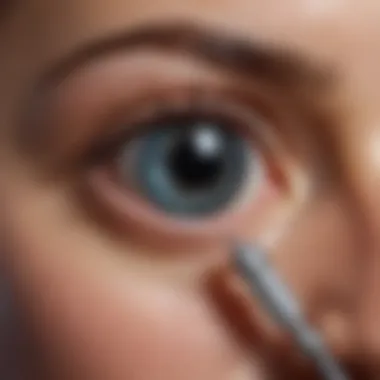Nose Endoscopy: Techniques and Clinical Applications


Intro
Nose endoscopy has transformed how medical professionals examine and diagnose nasal conditions. This approach facilitates a detailed view of the nasal cavity, allowing practitioners to identify issues that might not be visible through standard examination methods. Understanding this procedure encompasses not merely techniques but also its growing relevance within clinical environments.
The importance of this technique goes beyond mere curiosity for healthcare professionals. With advancements in technology, the range of applications continues to expand, addressing both common and complex nasal disorders. As we navigate the complexities of nose endoscopy, we will explore the recent advances, methodology, and the broader clinical significance of this procedure.
Preface to Nose Endoscopy
Nose endoscopy has emerged as an essential tool in modern medicine, particularly in the field of otolaryngology. This procedure allows for a thorough examination of the nasal cavity and is invaluable for diagnosing various conditions. Understanding the intricacies of nose endoscopy is vital for healthcare professionals as it can significantly influence both diagnostic accuracy and treatment strategies.
Benefits of nose endoscopy include its minimally invasive nature and the direct visualization it provides of the nasal anatomy. This technique can reveal detailed images of structures that are otherwise difficult to assess through traditional examination methods. As a result, nose endoscopy contributes to informed decision-making in clinical practice and enhances patient care.
Considerations related to nose endoscopy involve proper preparation and understanding the anatomy of the nasal cavity. The success of the procedure is contingent upon both the proficiency of the practitioner and the cooperation of the patient. Providing clear instructions during pre-procedural evaluations can reduce anxiety and ensure a smoother experience.
In summary, nose endoscopy represents a sophisticated intersection of technology and medical science, essential for precise diagnosis and treatment of nasal pathologies. Through this exploration, the article aims to illuminate the various facets of nose endoscopy and its significance in contemporary medical practice.
Defining Nose Endoscopy
Nose endoscopy is defined as a diagnostic procedure that utilizes an endoscope to visualize the interior of the nasal cavity. The endoscope, a thin tube equipped with a light and camera, enables physicians to capture real-time images of the nasal structures. This process is pivotal for identifying abnormalities such as polyps, tumors, or signs of infection.
Unlike other imaging techniques, nose endoscopy provides direct access to the nasal passages, allowing for a precise assessment. It is generally performed in an office setting or specialized clinic, ensuring patient comfort and convenience.
Historical Perspective
The history of nose endoscopy dates back to the early 20th century, marking a significant development in otolaryngological diagnostics. Initially, very basic instruments were used, limiting the clarity and detail of the images obtained. As technology evolved, flexible fiberoptic endoscopes were introduced, vastly improving the quality of visualization.
By the 1980s, advancements in camera technology and digital imaging transformed endoscopic procedures. This progress has led to the routine use of nasal endoscopy in clinical practice today. Continual improvements in instrumentation and techniques highlight an ongoing commitment to enhancing patient care and diagnostic efficacy.
Understanding the Anatomy of the Nasal Cavity
The anatomy of the nasal cavity is crucial for understanding nose endoscopy. Knowing the structures and their functions allows for accurate diagnoses and effective treatment. The nasal cavity is a complex system. Its anatomy includes various parts, such as the nasal septum, turbinates, and sinuses.
Overview of Nasal Structures
The nasal cavity consists of several key structures. The nasal septum divides the cavity into two nostrils. This septum is crucial for airflow and aids in temperature regulation. Turbinates are bony structures covered in mucous membrane. They help with humidifying and filtering the air. There are three pairs of turbinates: inferior, middle, and superior. Each plays a role in directing airflow.
Sinuses are air-filled spaces connected to the nasal cavity. These include the maxillary, frontal, ethmoid, and sphenoid sinuses. Their health is important for overall nasal function. Any obstruction or inflammation can lead to chronic sinusitis, making examination through nose endoscopy vital.
Functional Significance
Understanding the functional significance of these structures is essential. Proper nasal anatomy supports several physiological processes. The turbinates assist in regulating airflow and increasing the surface area for warming and humidifying air. The nasal cavity also traps and clears pathogens and particles, preventing them from entering the lungs.
Additionally, the sinuses contribute to the sound of our voice and aid in the reduction of skull weight. Blockages or abnormalities in these areas can result in various health issues, such as difficulty breathing or recurrent infections.
The knowledge of nasal anatomy is important in clinical practice. It helps healthcare providers recognize normal versus abnormal conditions during endoscopy. The detailed examination afforded by nose endoscopy plays a pivotal role in identifying issues that may not be evident through other methods.
Understanding the anatomy of the nasal cavity is a foundational aspect of effective diagnosis and treatment in otolaryngology.
The Procedure of Nose Endoscopy
The procedure of nose endoscopy is a critical aspect of this article, offering insights into how the practice is conducted, its significance in the medical field, and the various nuances involved. This detailed examination provides clarity regarding the steps taken prior to, during, and after endoscopy. Understanding this procedure is foundational for grasping how nasal pathologies are diagnosed and treated effectively. It also highlights the technological advances that make these procedures safer and more effective.


Preparation for Endoscopy
Patient Evaluation
Patient evaluation is a crucial first step before conducting a nose endoscopy. It ensures that the procedure is appropriate for the patient’s specific condition. The evaluation includes a comprehensive medical history, physical examination, and sometimes imaging studies. A key characteristic of patient evaluation is its tailored approach. Each patient presents unique factors that must be considered. This personalized aspect is beneficial as it helps in identifying possible risks associated with the procedure. One unique feature of patient evaluation is its role in developing an effective plan that addresses both surgical and non-surgical concerns. While this process can be time-consuming, the potential benefits significantly outweigh the disadvantages. Proper evaluation enhances patient safety and optimizes outcomes.
Pre-procedural Instructions
Pre-procedural instructions are another essential element leading up to endoscopy. These instructions help to prepare the patient for a successful procedure and minimize potential complications. Typically, patients are advised on dietary restrictions and the discontinuation of certain medications prior to the procedure. A key characteristic of pre-procedural instructions is their clarity and comprehensiveness. This characteristic is crucial for ensuring patients understand what is required of them. One unique feature of these instructions is the need to avoid blood thinners, which can increase the risk of bleeding during the procedure. While some may find these restrictions inconvenient, they serve as a protective measure to reduce complications and ensure that the procedure can proceed smoothly.
Instrumentation
Types of Endoscopes
The types of endoscopes used in nose endoscopy are central to the procedure. Each type serves different functions and is designed for specific tasks, enhancing the capabilities of the clinician. One key characteristic of these instruments is their ability to accommodate various imaging technologies, such as high-definition cameras. This adaptability makes them popular choices in medical settings. Moreover, the unique features of certain endoscopes—such as flexible versus rigid designs—offer tailored approaches that can accommodate diverse patient needs. Each type has its advantages, like the ability of flexible endoscopes to navigate complex anatomical structures, while rigid endoscopes provide enhanced stability.
Accessory Tools
Accessory tools accompany the endoscopes to enhance functionality during the procedure. These tools may include suction devices, cautery instruments, and forceps for tissue sampling. A key characteristic of accessory tools is their variety, allowing for broad applications in treatment and diagnosis. Their presence is beneficial as they offer multiple approaches to address specific issues encountered during endoscopy. One unique feature of accessory tools is their role in enabling therapeutic interventions, such as sinus drainage or polypectomy. Although the use of multiple tools can increase the complexity of the procedure, their advantages often outweigh the disadvantages by improving procedural efficiency and success rates.
Step-by-Step Procedure
Positioning of the Patient
Positioning of the patient is an integral part of the procedure. Proper positioning ensures that the clinician has optimal access to the nasal cavity during endoscopy. Typically, patients are seated comfortably with their heads tilted back slightly. A key characteristic of this positioning process is its direct impact on the visibility of nasal structures. It’s a beneficial strategy that facilitates a more thorough examination. One unique feature is that certain adjustments may be necessary based on the individual anatomy of the patient. While most positions are considered standard, deviations might be needed for maximized visual access. Though the adjustments may seem trivial, they are essential for achieving accurate diagnostic outcomes.
Prolusion of the Endoscope
The introduction of the endoscope marks the beginning of the actual procedure. Careful technique is required to minimize discomfort and ensure patient safety. A key characteristic of this phase is the gradual insertion of the endoscope, allowing the clinician to assess the patient’s reactions and comfort levels. This approach is beneficial as it reduces the chances of complications during insertion. The unique feature of this process is the real-time feedback obtained from the endoscope's visualization, yielding immediate insights into the patient’s nasal condition. While there is an inherent risk of discomfort during this phase, taking the time to conduct it carefully can mitigate these issues, leading to a smoother overall procedure.
Applications of Nose Endoscopy in Medicine
Nose endoscopy has a significant role in modern medical practice. It allows healthcare providers to visualize the internal structures of the nasal cavity. Such a detailed examination is vital for diagnosing and treating various nasal conditions effectively. The applications of nose endoscopy extend beyond mere observation; diagnostic and therapeutic capabilities make it a multi-dimensional tool in the clinician's arsenal. This section delves into two primary areas: diagnosis of nasal pathologies and therapeutic interventions.
Diagnosis of Nasal Pathologies
Diagnosis is a fundamental aspect of medical treatment. With nose endoscopy, practitioners can accurately identify nasal diseases, thereby tailoring treatment approaches based on specific findings.
Chronic Sinusitis
Chronic sinusitis is a common condition identified through nasal endoscopy. This condition arises from prolonged inflammation of the sinuses, which may result in congestion and other related symptoms. One key characteristic of chronic sinusitis is the presence of thickened nasal mucosa, often noted during the endoscopic examination. The ability to visualize these structures directly allows for better assessment than conventional methods, enhancing diagnostic accuracy.
The unique feature of using endoscopy in chronic sinusitis lies in its capacity to provide real-time insights. Healthcare professionals can observe the disease directly and assess the extent of mucosal changes. This is beneficial because it guides further treatment options, such as medical management or even surgical intervention when necessary.
Nasal Polyps
Nasal polyps are soft, painless growths within the nasal passages or sinuses, often associated with chronic inflammation. These polyps are another significant condition diagnosed through endoscopy. By using nose endoscopy, clinicians can visualize the size, location, and number of polyps present. This information is crucial as it directly influences treatment decisions.
A notable aspect of nasal polyps is their tendency to recur after treatment, thus necessitating ongoing monitoring. The use of endoscopy allows for repeat evaluations, aiding in the management of this chronic condition effectively. Physician awareness of the unique features of polyps assists in differentiating them from other pathological conditions.
Therapeutic Interventions
Beyond providing diagnostic information, nose endoscopy also serves as a platform for therapeutic interventions. The procedures facilitate direct actions taken during examinations, minimizing patient discomfort and optimizing outcomes. An overview of two such interventions follows.


Polypectomy
Polypectomy involves the removal of nasal polyps through endoscopic techniques. This procedure can alleviate symptoms such as nasal obstruction and improve the quality of life for affected individuals. The significant characteristic of polypectomy is that it can often be done on an outpatient basis, leading to reduced recovery times.
Notably, the advantage of using endoscopy for polypectomy is the precision it offers. Surgeons can target the polyps accurately, minimizing trauma to surrounding tissues. This aspect makes the procedure safer compared to traditional methods, underlining the importance of endoscopy in this context.
Sinus Drainage
Sinus drainage, another potential therapeutic intervention, focuses on opening the sinus drainage pathways, thus allowing for better ventilation and mucus drainage. This intervention is crucial for conditions like chronic sinusitis. One of the essential features of using endoscopy for sinus drainage is the capability to navigate the intricate anatomy of the nasal passages accurately.
The unique benefit of this method is its minimally invasive nature, reducing the risk of complications associated with more invasive procedures. Endoscopic sinus drainage enhances patient comfort and expedites recovery, making it a preferred choice in many scenarios.
Risks and Complications of Nose Endoscopy
Understanding the risks and complications associated with nose endoscopy is crucial for both healthcare professionals and patients. As a minimally invasive procedure, nose endoscopy holds many advantages, but it is not without its potential hazards. The awareness of such risks can improve patient safety and clinical outcomes. This section delves into the common side effects and serious complications, offering insights that might aid in clinical decision-making.
Common Side Effects
Common side effects following a nose endoscopy can range from mild discomfort to temporary physical reactions. These may include:
- Nasal congestion
- Minor bleeding from the nose
- Soreness in the nasal passages
- Sneezing and mild coughing
- Slight headache
Such side effects usually resolve quickly and do not require extensive intervention. However, understanding these effects is essential for managing patient expectations. Knowing that side effects can occur provides context to the patient's experience and enhances communication between the patient and healthcare provider, promoting a more satisfactory outcome.
Serious Complications
Despite the fact that serious complications are uncommon, they can occur. It is important to recognize the significant risks involved.
Bleeding
Bleeding is one of the most notable serious complications associated with nose endoscopy. This can happen during or after the procedure. The presence of blood vessels in the nasal cavity makes this a potential risk. If bleeding occurs, it can lead to considerable discomfort and may necessitate further intervention, such as cauterization or packing of the nasal passages.
This complication highlights the need for careful technique during the procedure. Practitioners must balance thorough examination with a cautious approach to avoid damaging delicate tissues. The risks of bleeding underscore the importance of patient assessment prior to endoscopy, particularly in those with pre-existing conditions that may affect coagulability.
Perforation
Perforation of the nasal or sinus tissue is another serious complication of nose endoscopy. This condition involves creating a hole in the tissue lining, which can lead to considerable adverse effects like chronic pain or increased risk of infection. The likelihood of perforation increases when navigating through complex anatomical regions or when using inappropriate techniques.
Recognizing the risk of perforation is essential. Healthcare professionals must perform a thorough evaluation of each patient's anatomy before proceeding. Additionally, proper technique and instrument selection are vital to minimize this risk.
In summary, while nose endoscopy is generally safe, understanding the potential risks and complications is necessary for both practitioners and patients. These insights contribute to improved clinical practices and heightened awareness, ultimately leading to better patient outcomes and satisfaction.
Patient Considerations and Care
Understanding the nuances of patient considerations and care in nose endoscopy is vital to ensuring a successful procedure and optimal recovery. This section highlights the essential elements that healthcare providers must prioritize to enhance patient outcomes and satisfaction.
Post-procedural Care
After a nose endoscopy, patients often require guidance on how to care for themselves. The healthcare provider will typically review important steps for recovery.
- Rest: Patients should allow their bodies the opportunity to heal. This often includes taking it easy for at least 24 hours following the procedure.
- Hydration: Keeping well-hydrated is key, especially if anesthetic medications were used during the endoscopy.
- Avoiding Irritants: Patients should steer clear of smoke, strong odors, or allergens for a few days post-procedure. These can irritate the nasal passages and complicate recovery.
- Medications: Any prescribed medications, particularly pain relief or antibiotics, should be taken as instructed. Proper use helps to avert complications, such as infection.
- Follow-up Appointments: Adhering to scheduled follow-up visits is important for monitoring recovery and assessing outcomes.


The overall effectiveness of nose endoscopy largely rests on how well patients follow these post-procedural instructions.
Managing Expectations
Educating patients about what to expect before, during, and after the endoscopy is crucial for reducing anxiety and enhancing the patient experience. Managing expectations involves several dimensions:
- Procedure Understanding: Providing a detailed explanation of the procedure allows patients to feel informed. Addressing their questions helps alleviate concerns.
- Recovery Time: Patients should be given a realistic timeline for recovery. Many patients may assume that they will return to normal activities immediately, but some may need several days.
- Possible Discomfort: Discussing potential discomfort or side effects, such as nasal congestion or minor bleeding, prepares patients for what they may experience. This can prevent undue alarm if such symptoms arise.
- Long-term Outlook: Depending on the diagnosis and treatment decisions made during the endoscopy, patients should gain an understanding of the long-term implications. This includes discussing follow-up care and any lifestyle changes that may be recommended.
By addressing these aspects, healthcare practitioners can significantly improve patient satisfaction and outcomes following nose endoscopy.
Effective communication is crucial in enhancing the quality of care and ensuring patients feel supported throughout their healthcare journey.
Future Directions in Nose Endoscopy
The field of nose endoscopy is evolving rapidly, with both technological advancements and ongoing research shaping its future. Understanding these developments is crucial for healthcare professionals and researchers. It sets the stage for improved diagnostic capabilities, enhanced patient care, and greater effectiveness in therapeutic interventions.
Technological Advancements
Technological progress has played a pivotal role in refining nose endoscopy. Innovations in imaging technology have led to higher resolution visuals, which enhance the clarity of the nasal cavity examination. High-definition endoscopes, such as those made by Karl Storz and Olympus, provide more detailed images, allowing practitioners to identify conditions such as chronic sinusitis or nasal tumors more accurately.
Moreover, the integration of 3D imaging technologies is transforming the way healthcare providers approach nasal procedures. 3D endoscopes are enabling a more comprehensive view of the nasal structure, guiding precision during surgical interventions like polypectomy.
A key element in these advancements is also the development of flexible endoscopes. Brand names like Pentax have introduced flexible options that improve maneuverability within the nasal cavity. This flexibility can translate to a less invasive experience for patients, minimizing discomfort and recovery time.
Research and Development Trends
Research in the domain of nose endoscopy is focusing on enhancing procedural efficacy and safety. Current trends are indicating a stronger emphasis on evidence-based practices. Numerous studies are investigating optimized protocols for pre-procedural care and post-operative recovery. This aims to standardize practices across different healthcare settings, ensuring consistency in patient outcomes.
Additionally, there is an increasing exploration of artificial intelligence applications in endoscopic procedures. AI can assist in real-time diagnosis, recognizing patterns from recorded data that may be missed by the human eye. Brands like Google have started to develop algorithms that may support doctors in interpreting endoscopic images, making diagnoses quicker and more reliable.
Overall, future directions in nose endoscopy will likely emphasize not only technological enhancement but also a stronger base in research and development to propel practices forward. As techniques continue to improve, healthcare professionals will harness these advancements to provide better patient outcomes.
"The evolution of technology and research in nose endoscopy heralds a new era of precision medicine, improving diagnosis and paving the way for innovative treatments."
These developments signify a broader shift toward a more personalized approach to patient care, firmly establishing the relevance of nose endoscopy in modern medicine.
Closure
The conclusion of this article serves as a fundamental component in reinforcing the vast significance of nose endoscopy within the medical field. As a technique that allows for direct visualization of the nasal cavity, it provides both diagnostic and therapeutic advantages that are crucial in contemporary otolaryngology.
The importance of nose endoscopy lies not only in its capability to diagnose complex nasal pathologies such as chronic sinusitis and nasal polyps but also in its role in facilitating interventions. Such procedures, including polypectomy and sinus drainage, can improve patient outcomes significantly. This precision is invaluable when addressing conditions that affect quality of life, including chronic obstructive pulmonary disease and allergies.
Moreover, this article has also highlighted future directions and advancements in technology, indicating a promising trajectory for the evolution of nasal endoscopy. Emerging tools and techniques are likely to increase the efficacy of these procedures while minimizing patient discomfort and recovery time.
In synthesizing the information presented throughout this investigation, it is clear that nose endoscopy is not merely a procedural technique; it embodies a philosophy of patient-centered care. As healthcare continues to progress, understanding the underlying details of such procedures will further empower professionals and enhance patient outcomes.
Summary of Key Points
- Definition and Scope: Nose endoscopy is a minimally invasive procedure used to examine the nasal cavity, essential in diagnosing various conditions.
- Anatomical Insights: A clear understanding of nasal anatomy is critical for effective endoscopic interventions.
- Procedural Details: Preparation, instrumentation, and the procedural steps have a direct impact on the success rates of the procedure.
- Applications in Diagnosis and Treatment: The technique aids in diagnosing chronic sinusitis and effectively facilitating therapeutic interventions.
- Risks and Patient Care: Awareness of possible complications and proper post-procedural care helps ensure patient safety and satisfaction.
- Future Trends: Technological innovations continue to evolve, expanding the scope and capabilities of nose endoscopy.
This summary reinforces the idea that nose endoscopy is a vital tool, not just for doctors but also for the well-being of patients. The ongoing evolution of this field is an essential area for ongoing study and development.
Cited Works and Further Reading
To ensure that readers have access to a wealth of information, a carefully curated list of cited works and further reading is provided. This selection will include:
- Peer-reviewed articles from journals such as the American Journal of Rhinology & Allergy and International Forum of Allergy & Rhinology. These sources often contain studies that explore the latest techniques and methods in nose endoscopy.
- Textbooks like Nasal and Sinus Surgery: A Comprehensive Approach for an extensive review of the subject matter, detailing both theoretical and practical aspects of the procedure.
- Online resources such as Wikipedia for introductory knowledge and a general understanding of concepts.
- Research articles available on platforms like PubMed for those seeking detailed studies and data about specific case practices and innovations in the field.
This structured approach not only promotes further learning but also accommodates different levels of knowledge and interest among students, researchers, and professionals.















